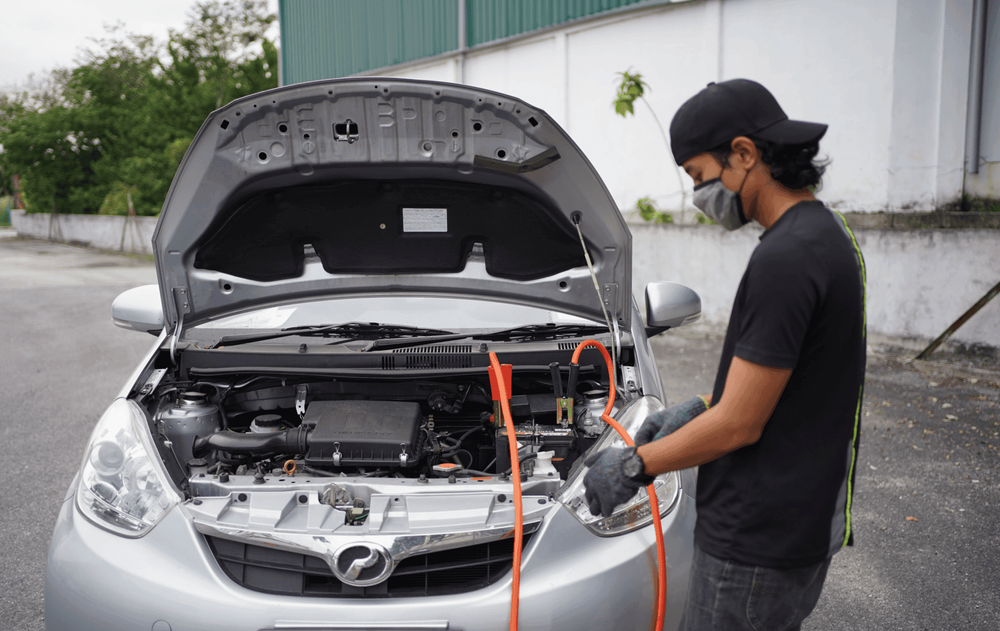Stranded with a dead car battery and need to know how to jump-start your car? We know how frustrating and inconvenient that can be.
But don’t worry! Knowing how to properly jump-start your car can save you time, money, and the hassle of waiting for roadside assistance. Let’s walk through the process step by step and ensure you’re back on the road safely.
Symptoms of a Dead Car Battery
Before jump-starting your car, it’s important to spot the signs of a dead or failing battery. Here’s a closer look at the key symptoms to watch out for so you can act quickly and avoid being stranded.
1. Engine Won’t Start
When you turn the key and the engine either cranks very slowly or doesn’t crank at all, it’s a clear sign your car battery is running out of juice. Slow cranking happens because the battery doesn’t have enough power to start the engine. If it doesn’t crank at all, it’s likely completely dead.
This symptom can be frustrating, especially if it catches you off guard during a busy day. If your car has been struggling to start for a few days, that’s your warning sign to check your battery health before it gives out completely.
2. Dim Lights
A weak car battery often shows up in your car’s electrical systems. If your headlights, interior lights, or dashboard lights look dim or flicker when you turn them on, it’s a red flag.
Headlights are directly powered by your battery, so dim lights indicate that the battery can’t provide enough energy. Dim interior lights may not seem like a big deal, but it’s your car’s way of telling you the battery is struggling.
3. Clicking Sound
When you turn the ignition key and hear a rapid clicking noise, this is often due to the starter motor not receiving enough power to fully engage. This clicking happens because the battery is too weak to send a consistent flow of energy to start the engine.
If this happens repeatedly, it’s time to test your battery and possibly replace it before it leaves you stranded.
4. Electrical Issues
Modern cars rely heavily on their electrical systems for comfort and functionality. A dying battery may cause power windows, windshield wipers, air conditioning, or even the car’s radio to malfunction or stop working altogether.
For instance, you might notice that your power windows move more slowly than usual, or your radio may turn on and off sporadically. These issues happen because the battery can’t supply enough energy to keep all these components running.
5. Battery Age
Car batteries typically last between 2 to 3 years. If your battery is nearing or past this range, it’s more likely to fail, especially if you’ve noticed other symptoms like slow starts or dim lights.
Keep track of your battery’s age by checking the manufacturing date, which is usually printed on the top or side of the battery. Regular battery inspections can help you plan for a replacement before it fails unexpectedly.
6. Strange Smell
If you detect a rotten egg smell coming from under the hood, it’s a strong indicator of a leaking or damaged battery. This odour is caused by sulphuric acid leaking from the battery, which could result from internal damage or overheating.
Not only is this a sign that your battery may be failing, but it’s also dangerous. Leaking acid can damage other components under your hood, and prolonged exposure to the fumes can be harmful. If you notice this smell, it’s time to replace the battery immediately.
Step-by-Step Guide to Jump-Start Your Car
1. Position the Vehicles and Turn Off Ignitions
Park both cars close enough for the jumper cables to reach, but ensure they don’t touch. Turn off the ignition in both vehicles and remove the keys to prevent electrical mishaps.
2. Connect the Jumper Cables
- Locate the positive (+) and negative (-) terminals on both batteries.
- Attach the positive clamp to the dead battery’s positive terminal, then the other positive clamp to the functioning battery’s positive terminal.
- Attach one negative clamp to the working battery’s negative terminal. Connect the remaining negative clamp to an unpainted metal surface on the engine block of the dead car for grounding.
3. Start the Working Car
Turn on the engine of the functioning vehicle and let it run for a few minutes. Slightly rev the engine to boost electrical output.
4. Start the Dead Car
Try starting the dead car. If it doesn’t start right away, let the functioning car run a bit longer before trying again. Once started, allow the revived car to run for a few minutes.
5. Safely Disconnect the Cables
Remove the jumper cables in reverse order:
- Negative clamp from the grounded surface.
- Negative clamp from the functioning battery.
- Positive clamp from the functioning battery.
- Positive clamp from the previously dead battery.
Avoid letting the clamps touch each other or any metal surface during removal.
Common Mistakes to Avoid While Jump-Starting Your Car
Jump-starting a car can save you a lot of hassle, but doing it wrong can lead to dangerous situations or even damage your vehicle.
Let’s go through the most common mistakes people make during a jump-start and how you can avoid them.
1. Skipping Battery Inspection
This is one mistake you can’t afford to make. Before you even think about attaching those jumper cables, take a closer look at the battery. Is it leaking fluid, swollen, or showing visible cracks?
These are all red flags. A damaged battery can cause serious accidents, including fires or explosions, if you try to jump-start it. In such cases, it’s safer to call a professional, like us at Bateriku to handle it.
2. Incorrect Cable Connection
Getting the cable connections wrong is a recipe for disaster. The red clamp must always go on the positive (+) terminal, and the black clamp should connect to the negative (-) terminal.
Mixing them up can cause sparks, damage your car’s sensitive electrical system, or even short-circuit the battery. Double-check the markings on your battery terminals before connecting, and always follow the right sequence to avoid costly mistakes.
3. Skipping Grounding
Many people don’t realize how important proper grounding is. Never attach the black (negative) clamp directly to the dead battery’s terminal. Instead, secure it to an unpainted metal part of the engine block.
This step reduces the risk of sparks near the battery, which could ignite any gases that might be leaking. Proper grounding is an essential safety step. Don’t skip it!
4. Turning On Electronics
When jump-starting your car, make sure all electrical devices are turned off. This includes headlights, the radio, air conditioning, and even charging cables for your devices. Why?
These electronics draw power from the battery, and a drained battery needs every bit of juice it can get. Turning them off minimizes the load and helps the jump-start process work more effectively.
5. Using Damaged Cables
Frayed or worn jumper cables are more than just an inconvenience – they’re a safety hazard. Damaged cables may fail to transfer enough power to jump-start the car or could even cause short circuits.
Before you start, take a moment to inspect the cables for any visible wear and tear. If you see exposed wires or cracks in the insulation, it’s time to replace them. Always keep a reliable set of cables in your car for emergencies.
6. Not Running the Engine Post-Jump
A common mistake people make is thinking the job is done as soon as the engine starts. But if you don’t let the car run for at least 15-20 minutes, the battery won’t have enough time to recharge.
Whether you’re idling or driving, this step gives the alternator a chance to replenish the battery’s charge. If you skip this, you might find yourself needing another jump-start sooner than you’d like!
Why These Steps Matter?
At Bateriku, we understand that jump-starting a car might seem intimidating, but following these guidelines can make it safe and effective. Your safety is our priority, and we’re always here to help if you’re ever in doubt.
With proper care and attention, you can avoid these common mistakes and get back on the road confidently.
Remember, if you ever feel unsure about jump-starting your car, just reach out to us. We’re just a call away and ready to assist you, anytime and anywhere!
Master the Art of Safe Jump-Starts and Stay Prepared with Bateriku!
Knowing how to safely jump-start a car is an invaluable skill. It saves time, keeps you on schedule, and lets you help others when needed. By following the proper steps and avoiding common mistakes, you’ll confidently handle a dead battery situation.
Need professional help? Contact Bateriku.com today for expert assistance and peace of mind!

